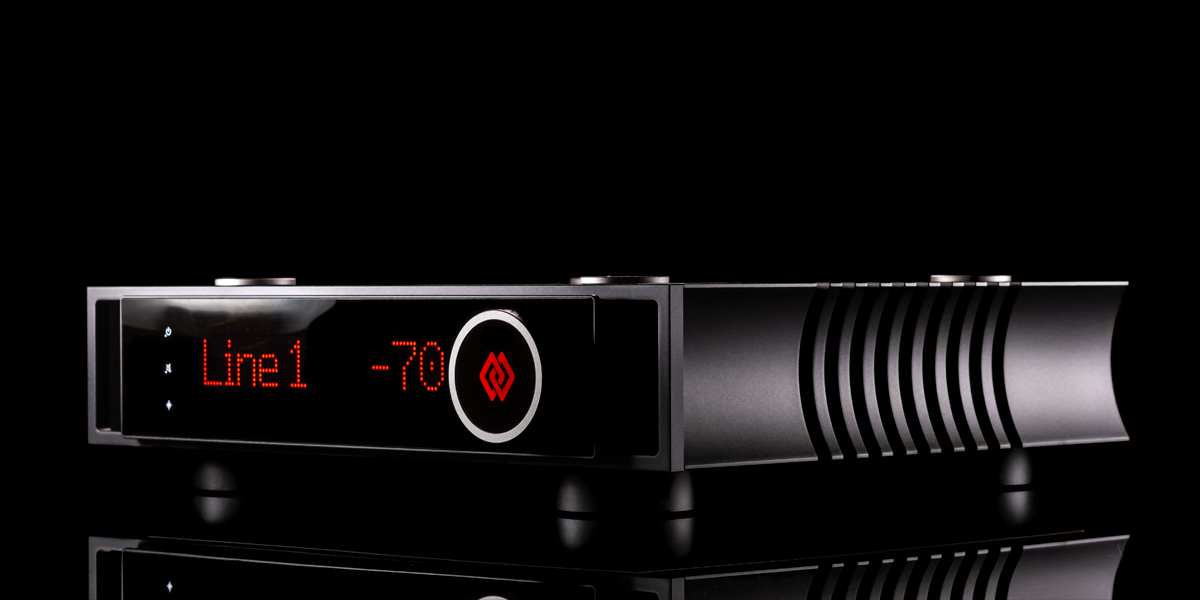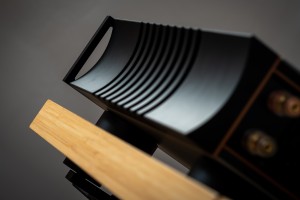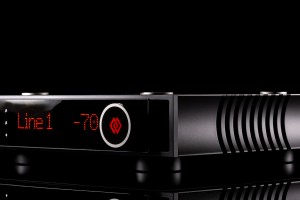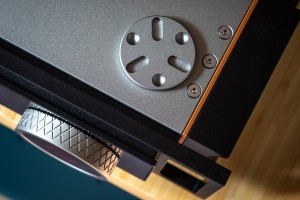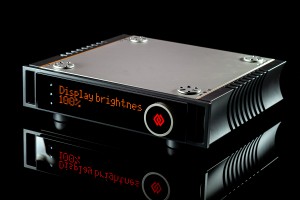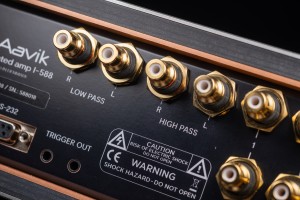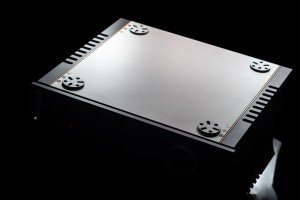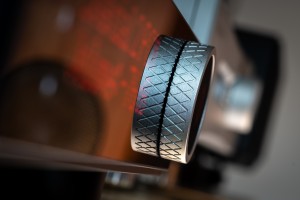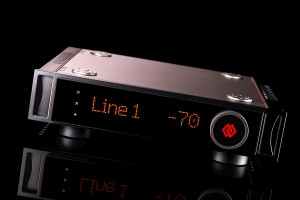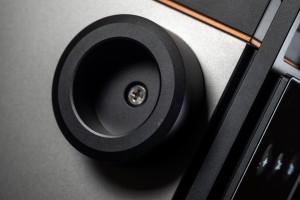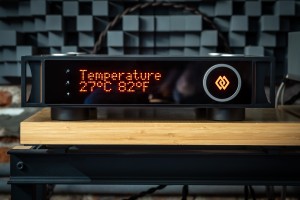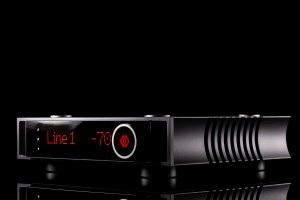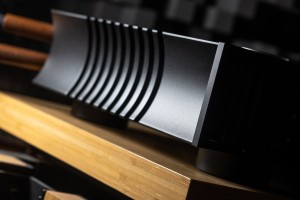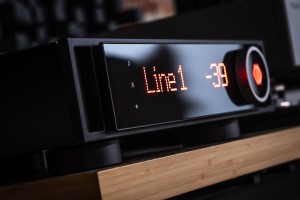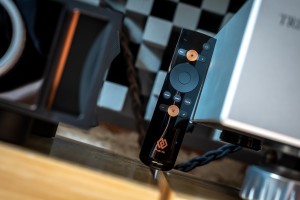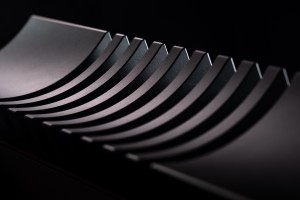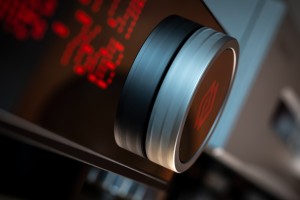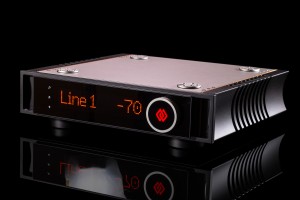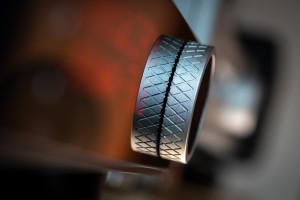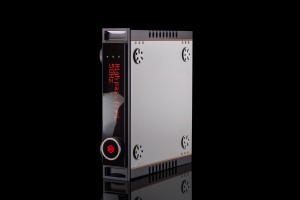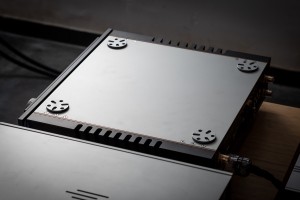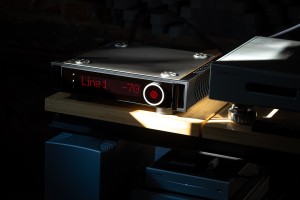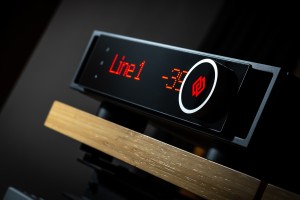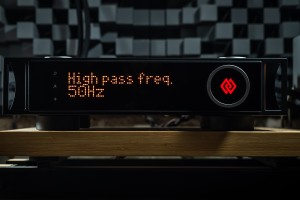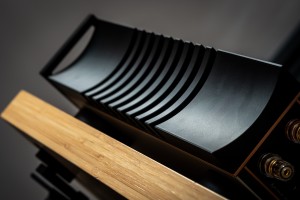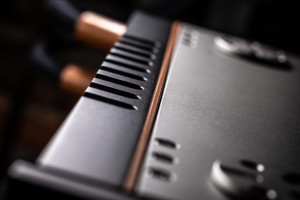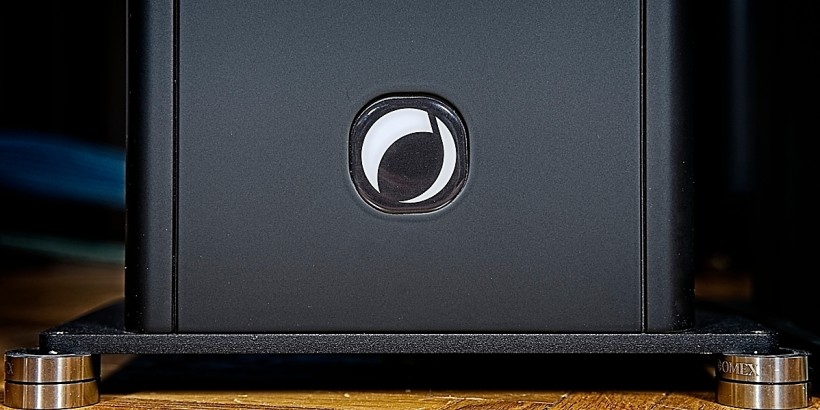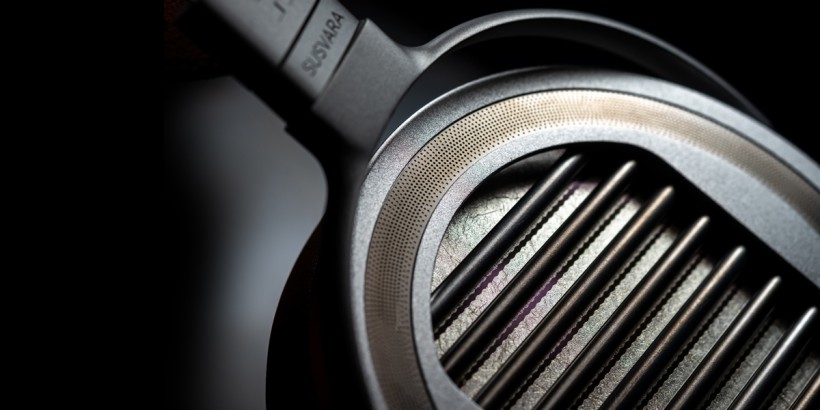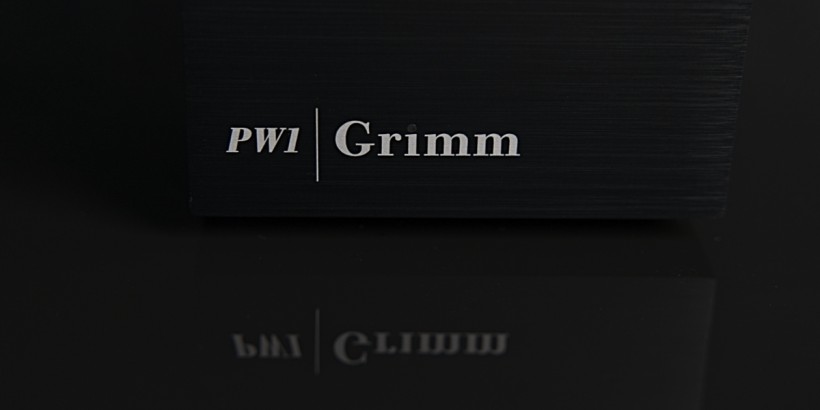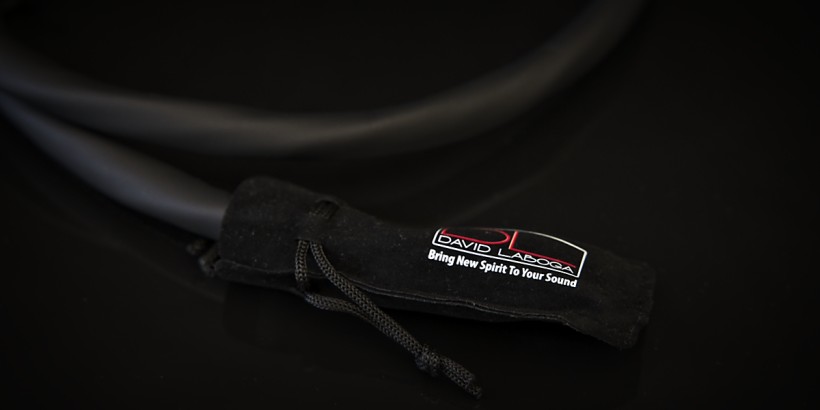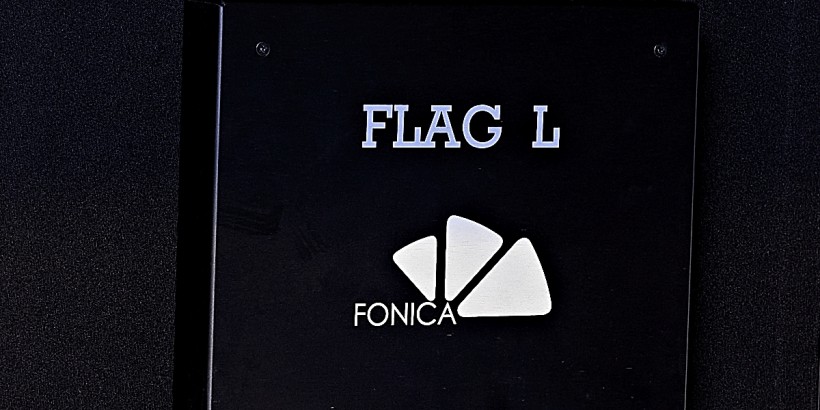Unveiled in June 2025, the Aavik I-x88-series integrated amplifiers mark the latest addition to the company’s lineup. Aavik I-588 is the second best of the range and our subject this time around. Enjoy!
The futurist
For years, I was a sucker for passive loudspeakers. Most of the systems I’ve built around them have felt honest and elegantly simple. Active and semi-active designs, by contrast, struck me as novelties — more about convenience than fidelity — and never compelling enough to tempt me away from my passive comfort zone. What shifted my perspective wasn’t a sudden conversion to actives, but a growing awareness that the real magic in loudspeaker design lies in not asking drivers to do jobs they’re neither fond of nor good at. That realization crystallized while reviewing Avantgarde’s Duo SD and Voxativ’s Alberich2. Both of these semi-active products rely on self-powered bass systems that unburden their high-efficiency transducers, letting them excel in their most natural ranges. These speakers impressed me not simply because they were semi-active, but because their frequency division was executed so intelligently.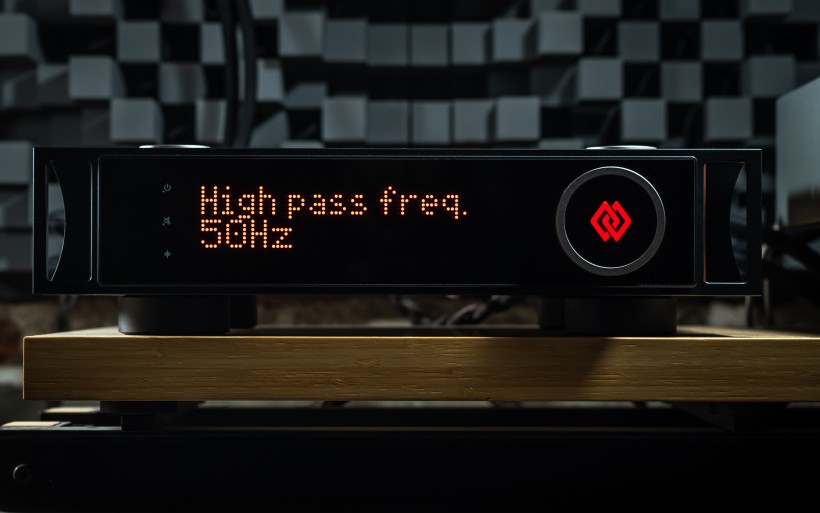 Which brings me to Aavik’s new I-x88 series. Although these are integrated amplifiers, they address the very same hand-off challenge from another angle. Where most amplifier makers either stop at the usual utilities or venture into all-in-one platforms, Aavik has introduced something genuinely rare: a discrete analog crossover network built directly into the amplifier. In essence, the I-x88 models can split the audio signal into low-pass and high-pass paths, managing the workload between a speaker’s drivers, or integrating them with a subwoofer without frequency overlap. If semi-active loudspeakers showcase the benefits of thoughtful frequency division on one front, Aavik’s I-x88 amplifiers echo that lesson on another. More importantly, crossover thinking at the amplifier level is virtually non-existent in the industry. That makes Aavik’s approach both niche and fundamentally different from competitors. While I was sent their Class-D flagship I-588 to find out how this rare idea works in practice, its retail price of € 30’000 also makes bold promises in terms of audible performance.
Which brings me to Aavik’s new I-x88 series. Although these are integrated amplifiers, they address the very same hand-off challenge from another angle. Where most amplifier makers either stop at the usual utilities or venture into all-in-one platforms, Aavik has introduced something genuinely rare: a discrete analog crossover network built directly into the amplifier. In essence, the I-x88 models can split the audio signal into low-pass and high-pass paths, managing the workload between a speaker’s drivers, or integrating them with a subwoofer without frequency overlap. If semi-active loudspeakers showcase the benefits of thoughtful frequency division on one front, Aavik’s I-x88 amplifiers echo that lesson on another. More importantly, crossover thinking at the amplifier level is virtually non-existent in the industry. That makes Aavik’s approach both niche and fundamentally different from competitors. While I was sent their Class-D flagship I-588 to find out how this rare idea works in practice, its retail price of € 30’000 also makes bold promises in terms of audible performance.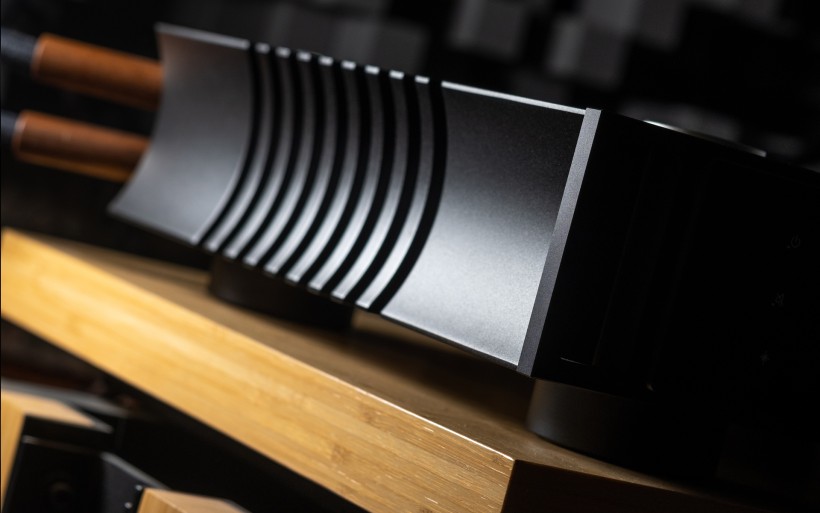 The I-588 arrived in a sturdy flight case with reinforced corners and locking latches, a reminder that Aavik treats shipping as seriously as the product itself. Inside, the amplifier was cushioned by thick foam inserts, with smaller compartments holding a manual, wool gloves and a remote-control wand finished with a detachable copper-colored backplate held in place by magnets. A single AAA cell powers this controller, which includes all the buttons one could need to operate the amp comfortably from the chair. At 440 x 430 x 116mm (W x D x H) and tipping the scales at 23.3kg, the I-588 is compact by high-end standards yet surprisingly hefty for its size. Behind its sleek exterior lies serious muscle: 300 watts per channel into 8Ω, doubling to 600 into 4Ω. With a damping factor hovering near 350, this is no polite lifestyle amp. It’s built to control challenging loudspeakers. Power comes from Pascal’s L-PRO2 UMAC Class-D module that’s stable as a rock, efficient and cool even under stress. Further specs list THD+N <0.0028% (1W, 1kHz, 8Ω), IMD/TIM below 0.0008%/0.002% (10W, 8Ω), 7.5Vrms max. output, line stage THD below 0.005% (1kHz, 1V) and standby/idle power draw respectively below 1/30W. Dead silence on idle and full readiness in about half a minute round out the technical résumé.
The I-588 arrived in a sturdy flight case with reinforced corners and locking latches, a reminder that Aavik treats shipping as seriously as the product itself. Inside, the amplifier was cushioned by thick foam inserts, with smaller compartments holding a manual, wool gloves and a remote-control wand finished with a detachable copper-colored backplate held in place by magnets. A single AAA cell powers this controller, which includes all the buttons one could need to operate the amp comfortably from the chair. At 440 x 430 x 116mm (W x D x H) and tipping the scales at 23.3kg, the I-588 is compact by high-end standards yet surprisingly hefty for its size. Behind its sleek exterior lies serious muscle: 300 watts per channel into 8Ω, doubling to 600 into 4Ω. With a damping factor hovering near 350, this is no polite lifestyle amp. It’s built to control challenging loudspeakers. Power comes from Pascal’s L-PRO2 UMAC Class-D module that’s stable as a rock, efficient and cool even under stress. Further specs list THD+N <0.0028% (1W, 1kHz, 8Ω), IMD/TIM below 0.0008%/0.002% (10W, 8Ω), 7.5Vrms max. output, line stage THD below 0.005% (1kHz, 1V) and standby/idle power draw respectively below 1/30W. Dead silence on idle and full readiness in about half a minute round out the technical résumé. 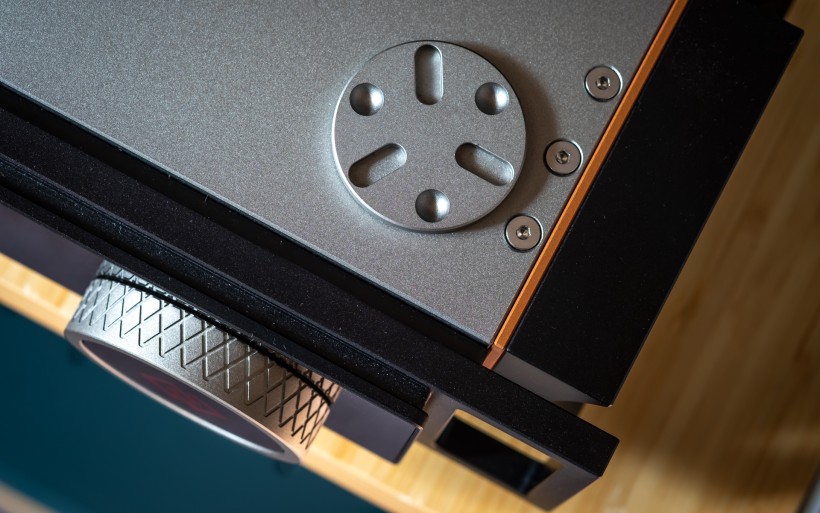 Within the company’s catalogue, the “I” series designates integrated amplifiers that forgo any digital circuitry — purely analog designs that unite preamplifier and power amplifier stages within a single chassis. Many seasoned listeners continue to favor this purist approach, valuing specialization over convergence. For owners of high-end DACs or turntables, amplifiers such as the I-588 present an ideal match. The crossover twist in it introduces several intriguing use-case scenarios. While adding a subwoofer to a stereo setup is the most obvious way to go about it, the real innovation lies elsewhere. In a typical system, a subwoofer extends low-frequency reach, yet the main speakers still reproduce bass — often redundantly. Ideally, the subwoofer should handle the bass exclusively, as it’s generally better equipped for that task than the woofers in most speakers. Achieving this separation requires a way to prevent the main speakers from producing low frequencies. That’s precisely what the I-588’s high-pass filter accomplishes. Most subwoofers are active designs, equipped with built-in low-pass filters that define the upper limit of their operating range. The Aavik I-588 includes a similar filter, enabling the use of a passive subwoofer if desired. Since the amplifier’s high- and low-pass filters can operate simultaneously, they can also be configured as a notch filter to suppress a particularly problematic room resonance. Moreover, if the connected speakers support bi-amping, the I-588’s crossover network enables precise fine-tuning of the frequency ranges delivered to individual drivers — often yielding audible improvements in performance. Later on, I’ll delve deeper into how this crossover system operates in real-world use.
Within the company’s catalogue, the “I” series designates integrated amplifiers that forgo any digital circuitry — purely analog designs that unite preamplifier and power amplifier stages within a single chassis. Many seasoned listeners continue to favor this purist approach, valuing specialization over convergence. For owners of high-end DACs or turntables, amplifiers such as the I-588 present an ideal match. The crossover twist in it introduces several intriguing use-case scenarios. While adding a subwoofer to a stereo setup is the most obvious way to go about it, the real innovation lies elsewhere. In a typical system, a subwoofer extends low-frequency reach, yet the main speakers still reproduce bass — often redundantly. Ideally, the subwoofer should handle the bass exclusively, as it’s generally better equipped for that task than the woofers in most speakers. Achieving this separation requires a way to prevent the main speakers from producing low frequencies. That’s precisely what the I-588’s high-pass filter accomplishes. Most subwoofers are active designs, equipped with built-in low-pass filters that define the upper limit of their operating range. The Aavik I-588 includes a similar filter, enabling the use of a passive subwoofer if desired. Since the amplifier’s high- and low-pass filters can operate simultaneously, they can also be configured as a notch filter to suppress a particularly problematic room resonance. Moreover, if the connected speakers support bi-amping, the I-588’s crossover network enables precise fine-tuning of the frequency ranges delivered to individual drivers — often yielding audible improvements in performance. Later on, I’ll delve deeper into how this crossover system operates in real-world use.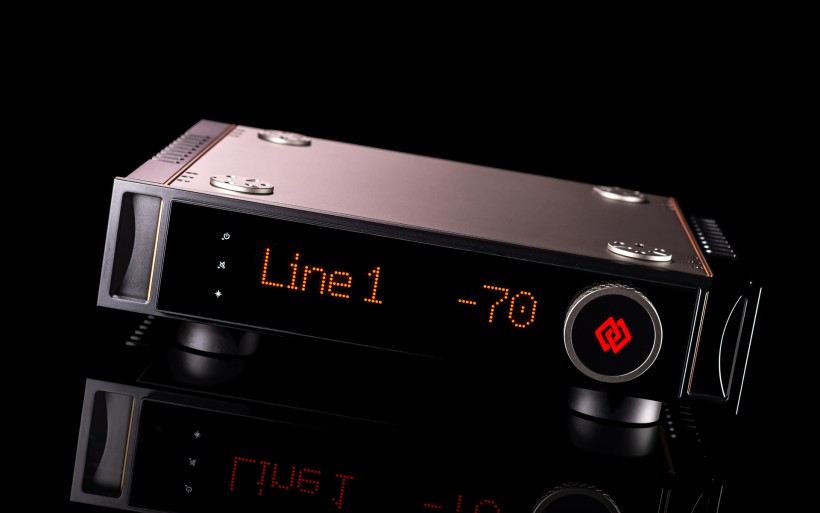 At Audio Group Denmark, aluminium is considered a poor choice for casings, while titanium, zirconium, copper and wood-based laminates are celebrated for their damping and shielding abilities. Although the I-588 isn’t as extravagant as the I-880, it still reflects that philosophy in full. Its forehead combines a robust steel panel with side handles, dominated by a large red dot-matrix display that’s easy to read across the room. On the right sits a beautifully machined knob with a titanium grip — endlessly rotating, perfectly weighted, and oddly addictive to use. That part of the I-588’s UI is as good as it gets. Three touch buttons integrated into the display handle standby on/off that also doubles as the arrow up, then there’s the mute/arrow down below it and input/menu selector on the bottom. The menu allows a user to set display brightness (10/40/70 and 100%), dim it, adjust channel balance (up to 6dB), monitor temperature, set the home theatre bypass input and its level (up to -20dB), check OS version, do a factory reset, separately set high/low-pass cut-off frequency (30-80Hz) and adjust low-pass level (+/-6dB in 0.25dB steps). I didn’t miss a single thing.
At Audio Group Denmark, aluminium is considered a poor choice for casings, while titanium, zirconium, copper and wood-based laminates are celebrated for their damping and shielding abilities. Although the I-588 isn’t as extravagant as the I-880, it still reflects that philosophy in full. Its forehead combines a robust steel panel with side handles, dominated by a large red dot-matrix display that’s easy to read across the room. On the right sits a beautifully machined knob with a titanium grip — endlessly rotating, perfectly weighted, and oddly addictive to use. That part of the I-588’s UI is as good as it gets. Three touch buttons integrated into the display handle standby on/off that also doubles as the arrow up, then there’s the mute/arrow down below it and input/menu selector on the bottom. The menu allows a user to set display brightness (10/40/70 and 100%), dim it, adjust channel balance (up to 6dB), monitor temperature, set the home theatre bypass input and its level (up to -20dB), check OS version, do a factory reset, separately set high/low-pass cut-off frequency (30-80Hz) and adjust low-pass level (+/-6dB in 0.25dB steps). I didn’t miss a single thing.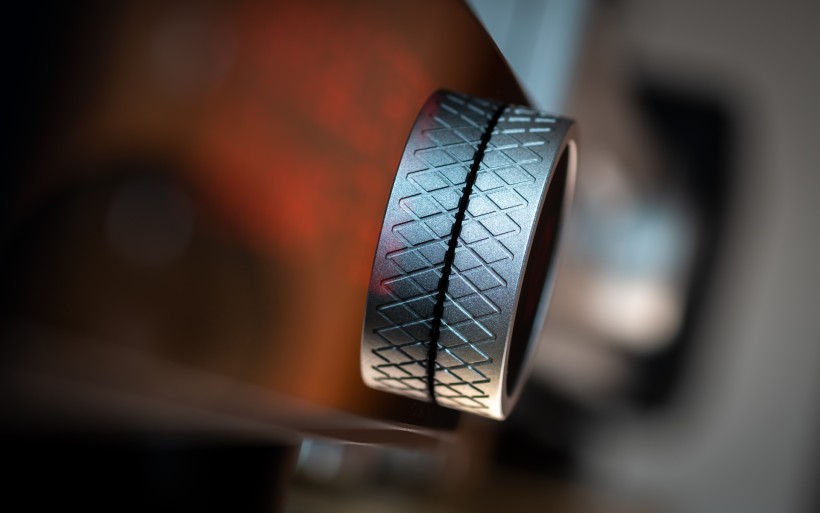 From the side the I-588 looks just as impressive as from the front. Its concave flanks contrast with the convex cheeks of the I-880, while inside they connect to heavy copper walls that form a shielded chamber to protect the circuitry from airborne noise. What used to be exclusive to Aavik’s most expensive models is now standard across the line, and here it’s paired with the company’s familiar thick wood-composite sandwich top and bottom panels to suppress vibration. Four round inserts on the top allow stacking with other Aavik components, either directly or via the optional Ansuz Darkz decouplers. The former connection requires a dozen ball bearings, the latter wants twice as many. The amp sits on four large footers designed to interface seamlessly with those pucks, hiding them almost entirely while still ensuring contact with a rack shelf. Around the back, the I-588 features solid but conventional speaker terminals, a fused IEC power inlet, trigger and software update ports, and a practical array of RCA connections; five line-level inputs, along with dedicated main input and separate high-pass (24dB/oct.), low-pass (12dB/oct.), and preamp outputs.
From the side the I-588 looks just as impressive as from the front. Its concave flanks contrast with the convex cheeks of the I-880, while inside they connect to heavy copper walls that form a shielded chamber to protect the circuitry from airborne noise. What used to be exclusive to Aavik’s most expensive models is now standard across the line, and here it’s paired with the company’s familiar thick wood-composite sandwich top and bottom panels to suppress vibration. Four round inserts on the top allow stacking with other Aavik components, either directly or via the optional Ansuz Darkz decouplers. The former connection requires a dozen ball bearings, the latter wants twice as many. The amp sits on four large footers designed to interface seamlessly with those pucks, hiding them almost entirely while still ensuring contact with a rack shelf. Around the back, the I-588 features solid but conventional speaker terminals, a fused IEC power inlet, trigger and software update ports, and a practical array of RCA connections; five line-level inputs, along with dedicated main input and separate high-pass (24dB/oct.), low-pass (12dB/oct.), and preamp outputs.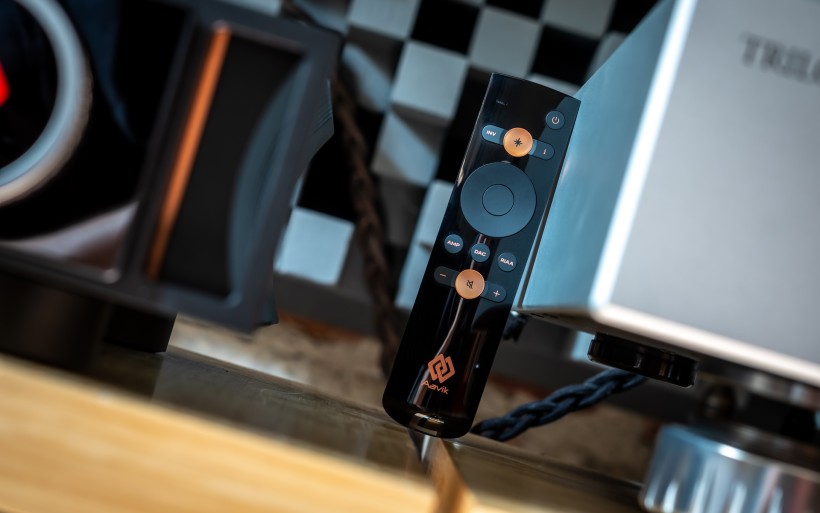 When I first encountered the I-880, I felt its industrial design and fit ’n’ finish had established an almost untouchable benchmark. The I-588 does nothing to diminish that impression. Though marginally more restrained in its material palette—substituting an acrylic fascia and steel elements for the tempered glass and titanium of its flagship sibling—it remains firmly in the same upper echelon of build execution. The enclosure exudes quiet luxury, blending visual elegance with functional precision, and stands as a clear advancement over Aavik’s previous-generation designs. Internally, the I-588 bristles with Ansuz’s latest-gen anti-noise technologies. 108 active and 240 squared Tesla coils each occupy their own laminate, operating in parallel with the signal circuits according to the same underlying principle. When one coil leg experiences a voltage spike, its counterpart instantly generates a counter-spike to neutralize incoming noise in real time. On the same board are 10 scalar dithering ICs, which modulate the ground noise floor by injecting precisely defined squared frequencies into the signal—somewhat analogous to the operational principle of marine sonar systems. Seven of the company’s anti-aerial resonance coils, positioned near the speaker terminals, now feature gold-coated windings around zirconium rods. The Pascal Class-D UMAC L-PRO2 stereo power amplifier module with its integrated power supply was selected for its very high output capability and PWM stage that generates a sine-based rather than triangular waveform, effectively minimizing ultra-high-frequency noise. Additionally, feedback is taken after the low-pass output coils, a design choice that substantially reduces output impedance and enhances control over the load. The crossover network enjoys discrete components and its own board, piggybacked atop the main PCB. Finally, volume attenuation is handled in the analog domain via a precision resistor-ladder network within a dedicated chip.
When I first encountered the I-880, I felt its industrial design and fit ’n’ finish had established an almost untouchable benchmark. The I-588 does nothing to diminish that impression. Though marginally more restrained in its material palette—substituting an acrylic fascia and steel elements for the tempered glass and titanium of its flagship sibling—it remains firmly in the same upper echelon of build execution. The enclosure exudes quiet luxury, blending visual elegance with functional precision, and stands as a clear advancement over Aavik’s previous-generation designs. Internally, the I-588 bristles with Ansuz’s latest-gen anti-noise technologies. 108 active and 240 squared Tesla coils each occupy their own laminate, operating in parallel with the signal circuits according to the same underlying principle. When one coil leg experiences a voltage spike, its counterpart instantly generates a counter-spike to neutralize incoming noise in real time. On the same board are 10 scalar dithering ICs, which modulate the ground noise floor by injecting precisely defined squared frequencies into the signal—somewhat analogous to the operational principle of marine sonar systems. Seven of the company’s anti-aerial resonance coils, positioned near the speaker terminals, now feature gold-coated windings around zirconium rods. The Pascal Class-D UMAC L-PRO2 stereo power amplifier module with its integrated power supply was selected for its very high output capability and PWM stage that generates a sine-based rather than triangular waveform, effectively minimizing ultra-high-frequency noise. Additionally, feedback is taken after the low-pass output coils, a design choice that substantially reduces output impedance and enhances control over the load. The crossover network enjoys discrete components and its own board, piggybacked atop the main PCB. Finally, volume attenuation is handled in the analog domain via a precision resistor-ladder network within a dedicated chip. 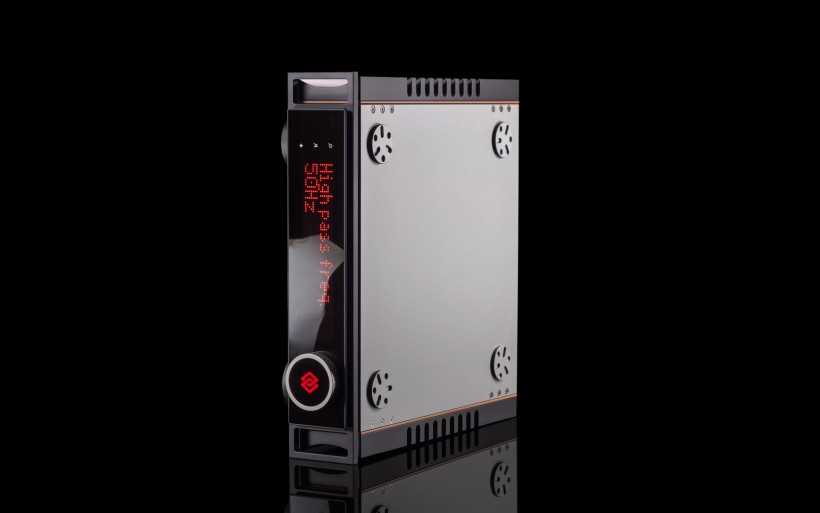 The recently reviewed Aavik U-188 left no room for guesswork as far as its ideal use case scenario was concerned. This full-fledged do-it-all deck didn’t want anything above speakers and LAN access. Meanwhile, the Aavik I-588 loaner packed fewer utilities and naturally demanded more hardware. In my system it replaced the Trilogy 915R/995R analog end, so via RCAs it connected to the Horizon360 DAC that received data from the Innuos Statement Next-Gen streamer/server. Since the I-588 loaner and its U-188 sibling rock the same Class-D amp circuit, Boenicke W11 SE+ floorstanders were the natural and quite frankly ideal load for today’s machine, but not the only one. More about that in a bit. This Aavik saw the usual power cord, speaker cables and twin daisy-chained outlet multipliers, all with LessLoss tech inside. The same company’s Giant Steps footers provided the potent anti-vibration support.
The recently reviewed Aavik U-188 left no room for guesswork as far as its ideal use case scenario was concerned. This full-fledged do-it-all deck didn’t want anything above speakers and LAN access. Meanwhile, the Aavik I-588 loaner packed fewer utilities and naturally demanded more hardware. In my system it replaced the Trilogy 915R/995R analog end, so via RCAs it connected to the Horizon360 DAC that received data from the Innuos Statement Next-Gen streamer/server. Since the I-588 loaner and its U-188 sibling rock the same Class-D amp circuit, Boenicke W11 SE+ floorstanders were the natural and quite frankly ideal load for today’s machine, but not the only one. More about that in a bit. This Aavik saw the usual power cord, speaker cables and twin daisy-chained outlet multipliers, all with LessLoss tech inside. The same company’s Giant Steps footers provided the potent anti-vibration support.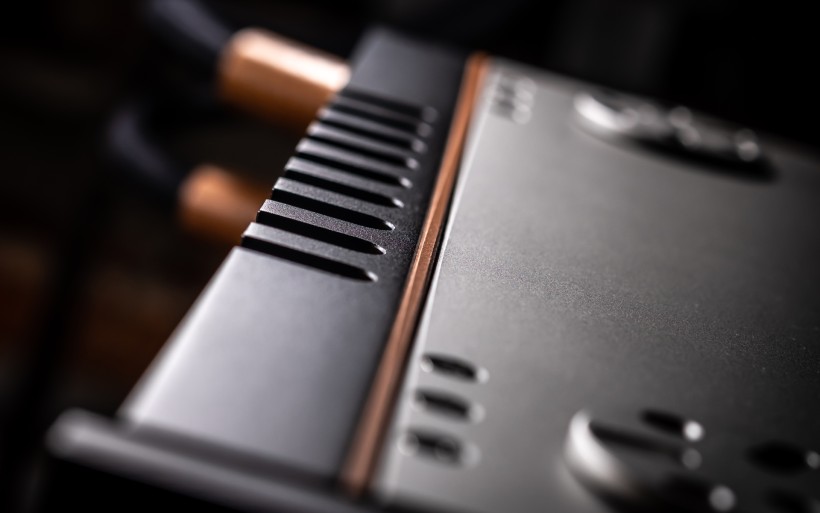 For starters, let me shamelessly copy the below part of my U-188 review, where I wrote that: “…ported bass is a wide subject. Some speakers do it better than others. Although Boenicke W11 SE+ feature narrow venting slots on the rear, you couldn’t tell upon connecting them to a powerful amp with very low output impedance. Then these floorstanders hit very hard, reach very low and develop enough edges and composure downstairs to behave like a sealed box busy with a large bass cone or two. Long story short, the U-188 brilliantly fit this profile and was the amp in question. While Trilogy 995R monos do 200/350wpc into 8/4Ω respectively, their output impedance is significantly higher than the Aavik’s, so their control over a woofer’s rear strokes is far lesser. One rapid bass-intense track fully sufficed to map which amp of the two was the significantly better match for the W11 SE+. The Dane’s Class-D internals boasted just the ideal blend of traits to correctly support these floorstanders and present their core voice as their maker intended. In fact, this is the very reason why Sven Boenicke has been vocal about his speakers’ fondness for Class-D amps. He simply knows that they truly thrive on copious output power and damping. As far as his speakers are concerned, mechanical compliance always goes above money. A while ago the Axxess AiO that also connected to my W11 SE+ already stressed that. The U-188 with much higher mandatory specs and far dearer sticker simply was expected to do way more atop that with the same load.”
For starters, let me shamelessly copy the below part of my U-188 review, where I wrote that: “…ported bass is a wide subject. Some speakers do it better than others. Although Boenicke W11 SE+ feature narrow venting slots on the rear, you couldn’t tell upon connecting them to a powerful amp with very low output impedance. Then these floorstanders hit very hard, reach very low and develop enough edges and composure downstairs to behave like a sealed box busy with a large bass cone or two. Long story short, the U-188 brilliantly fit this profile and was the amp in question. While Trilogy 995R monos do 200/350wpc into 8/4Ω respectively, their output impedance is significantly higher than the Aavik’s, so their control over a woofer’s rear strokes is far lesser. One rapid bass-intense track fully sufficed to map which amp of the two was the significantly better match for the W11 SE+. The Dane’s Class-D internals boasted just the ideal blend of traits to correctly support these floorstanders and present their core voice as their maker intended. In fact, this is the very reason why Sven Boenicke has been vocal about his speakers’ fondness for Class-D amps. He simply knows that they truly thrive on copious output power and damping. As far as his speakers are concerned, mechanical compliance always goes above money. A while ago the Axxess AiO that also connected to my W11 SE+ already stressed that. The U-188 with much higher mandatory specs and far dearer sticker simply was expected to do way more atop that with the same load.”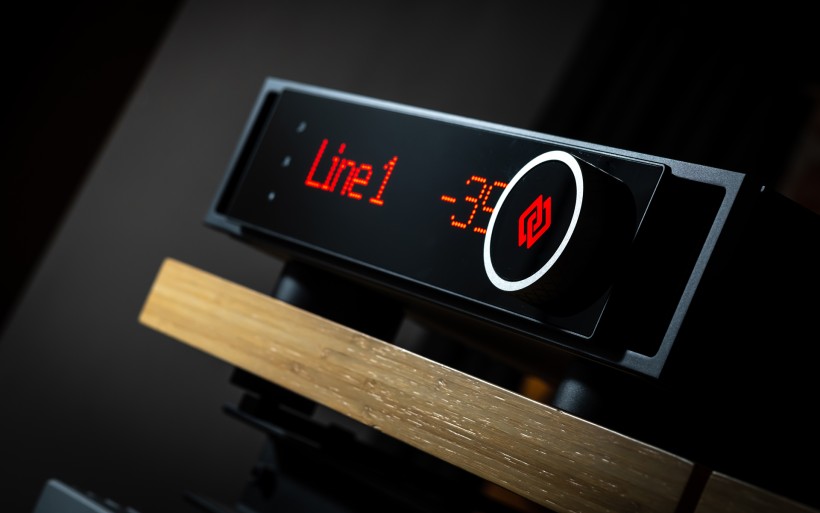 “And it did, but first things first. When connected to the Aavik not Trilogy monos, W11 SE+ produced bass that dug deeper, was sensibly more controlled, punctual and cleaner. The usual residual bloat and fuzz as the byproducts of weak bass control and resulting port farts didn’t register. The balance between contour, textural fill and overall gravitas was maintained to a point where I had no reasons to complain. Boenicke speakers gladly flaunted their tectonic prowess, elasticity and articulation, so traits which naturally boosted the sensation of spatial liberation, might, shove, scale, openness and directness. That’s exactly how it should be. Although there and then the W11 SE+ once more proved extremely good on bass, that hadn’t become the key focal point but the very foundation for all above it. To simplify, these speakers sound truly gargantuan imaging wise only when their downstairs is in check. The Aavik fully secured that feeling, twin 995Rs not quite as much. While these mono amps are sublime with high-eff speakers all across the board, with the W11 SE+ they produced bass that was lazier, shallower, bloomier and nowhere near as clean, so consequently the entire aural landscape was sensibly smaller, stuffier and not as radiant and lucid.”
“And it did, but first things first. When connected to the Aavik not Trilogy monos, W11 SE+ produced bass that dug deeper, was sensibly more controlled, punctual and cleaner. The usual residual bloat and fuzz as the byproducts of weak bass control and resulting port farts didn’t register. The balance between contour, textural fill and overall gravitas was maintained to a point where I had no reasons to complain. Boenicke speakers gladly flaunted their tectonic prowess, elasticity and articulation, so traits which naturally boosted the sensation of spatial liberation, might, shove, scale, openness and directness. That’s exactly how it should be. Although there and then the W11 SE+ once more proved extremely good on bass, that hadn’t become the key focal point but the very foundation for all above it. To simplify, these speakers sound truly gargantuan imaging wise only when their downstairs is in check. The Aavik fully secured that feeling, twin 995Rs not quite as much. While these mono amps are sublime with high-eff speakers all across the board, with the W11 SE+ they produced bass that was lazier, shallower, bloomier and nowhere near as clean, so consequently the entire aural landscape was sensibly smaller, stuffier and not as radiant and lucid.” 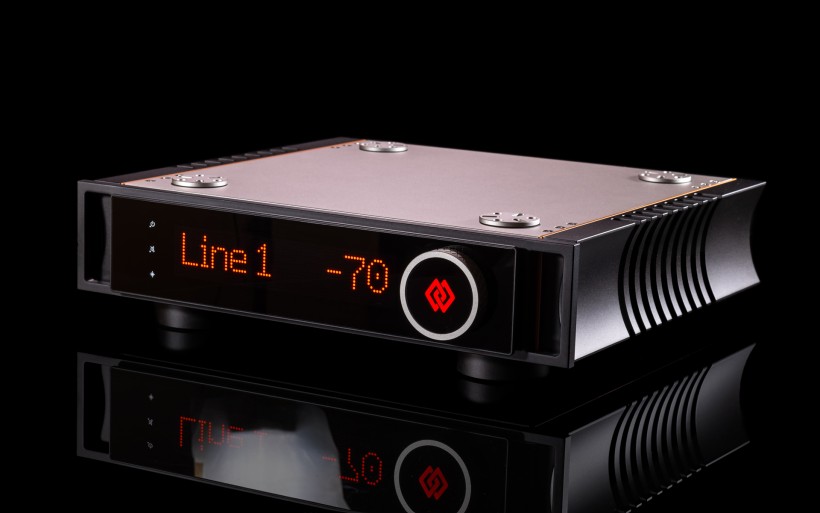 It’s also worth pointing out that, while it’s a multi-driver type, Boenicke W11 SE+ largely sounds like a point-source design that has freshness, illumination, quickness, openness, spatial accuracy, precision and resolution as its predominant assets. As unusual as these Swiss sepakers are, they’re also somewhat lean, shy on substance and a touch frosty, which is why muscle amps groomed for generous body and tone provision are ace companions for them. While Trilogy 995R monos work remarkably well on that particular score, many modern Class-D amps also follow suit. Switching circuits of those under brands Axxess and Aavik are supported by specialist noise-rejecting means designed specifically to lower their noise floor. The contribution of these vital boosters pays dividends in sound that is inherently sporty and controlling indeed, but also juicy, earthy, packed with color and even satisfyingly soft and warm with music that cherishes these artsy aspects. My point is that the Axxess Forté and Aavik U-188 weren’t dry, pale, mechanical or lean in the slightest. If a recording allowed, they weren’t also excessively shiny, pointy, piercing or brittle. In my room, these two AiOs were clueless how to do any of these undesirable things. They also kept listening fatigue at the door.
It’s also worth pointing out that, while it’s a multi-driver type, Boenicke W11 SE+ largely sounds like a point-source design that has freshness, illumination, quickness, openness, spatial accuracy, precision and resolution as its predominant assets. As unusual as these Swiss sepakers are, they’re also somewhat lean, shy on substance and a touch frosty, which is why muscle amps groomed for generous body and tone provision are ace companions for them. While Trilogy 995R monos work remarkably well on that particular score, many modern Class-D amps also follow suit. Switching circuits of those under brands Axxess and Aavik are supported by specialist noise-rejecting means designed specifically to lower their noise floor. The contribution of these vital boosters pays dividends in sound that is inherently sporty and controlling indeed, but also juicy, earthy, packed with color and even satisfyingly soft and warm with music that cherishes these artsy aspects. My point is that the Axxess Forté and Aavik U-188 weren’t dry, pale, mechanical or lean in the slightest. If a recording allowed, they weren’t also excessively shiny, pointy, piercing or brittle. In my room, these two AiOs were clueless how to do any of these undesirable things. They also kept listening fatigue at the door.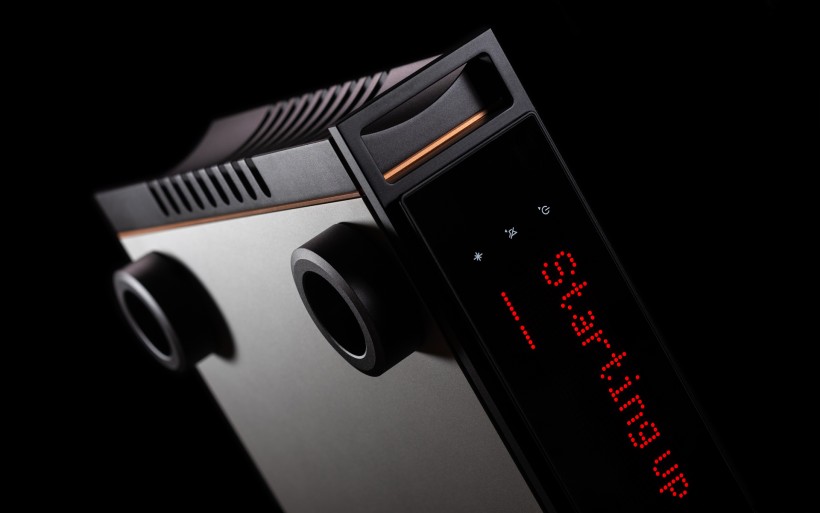 Considering all the above, the Aavik I-588 tamed the dastardly Swiss load just as well as its U-188 sibling. As I’ve explained, their identical amplifier stages already suggested that. This means that the W11 SE+ fronted by the integrated Aavik sounded brilliantly on all the adrenaline-inducing counts. In my room, the result was immensely agile, thunderous, snappy, controlling and all in all pleasantly savage, while the amount of air pushed effortlessly towards me made the view properly engaging and vibrant. The Boenicke speakers also dug impressively low. Let me stress again that this is possible only with an amp that has full control over their hard-hung woofer arsenal. In comparison to the U-188 however, several things about the I-588’s behavior were different. My reference DAC and server/streamer are remarkably quick, detailed, spatially large and direct machines. They also flaunt their excellence on tone, color, smoothness and density. While the U-188 was awesome as a one-box AiO design, my digital hardware supported the I-588 in a way that produced clearly higher-tiered sound overall. That’s how it’s supposed to be. Amps as costly as this one ought to easily communicate what electronics before them do, and mine are what they are.
Considering all the above, the Aavik I-588 tamed the dastardly Swiss load just as well as its U-188 sibling. As I’ve explained, their identical amplifier stages already suggested that. This means that the W11 SE+ fronted by the integrated Aavik sounded brilliantly on all the adrenaline-inducing counts. In my room, the result was immensely agile, thunderous, snappy, controlling and all in all pleasantly savage, while the amount of air pushed effortlessly towards me made the view properly engaging and vibrant. The Boenicke speakers also dug impressively low. Let me stress again that this is possible only with an amp that has full control over their hard-hung woofer arsenal. In comparison to the U-188 however, several things about the I-588’s behavior were different. My reference DAC and server/streamer are remarkably quick, detailed, spatially large and direct machines. They also flaunt their excellence on tone, color, smoothness and density. While the U-188 was awesome as a one-box AiO design, my digital hardware supported the I-588 in a way that produced clearly higher-tiered sound overall. That’s how it’s supposed to be. Amps as costly as this one ought to easily communicate what electronics before them do, and mine are what they are.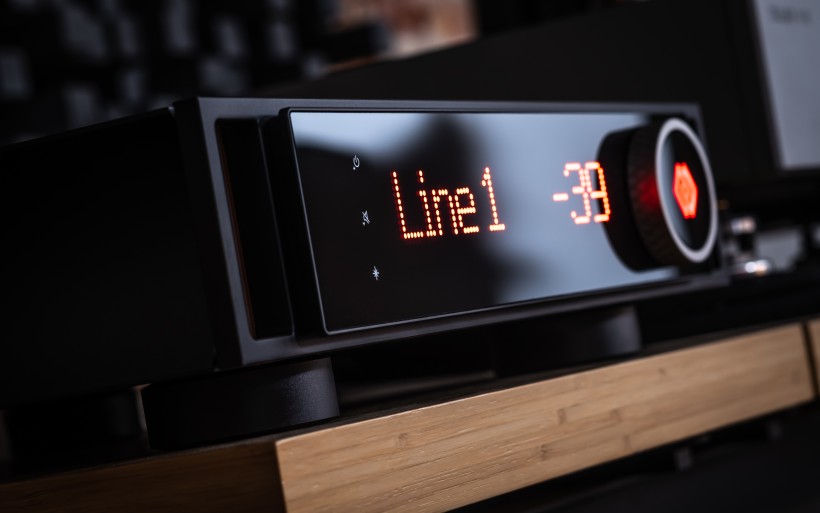 The W11 SE+ fronted by the Aavik I-588, Horizon360 DAC and Innuos Statement Next-Gen server/streamer not only was highly talented on might, shove, momentum, illumination and all the other sporty fronts, but it also sounded pleasantly voluptuous and seductive in a way that manifested through sensuality, intimacy and moisture rather than overly syrupy and hooded perspective. If my digital hardware helped today’s integrated amp a lot in achieving such a fantastic outcome, so did various noise-rejecting Ansuz technologies inside it. Squads of these bits are responsible particularly for injecting generous smoothness, color and backdrop blackness into music, and also stomping on many Class-D stereotypes. Without knowing what hides under the I-588’s bonnet, many well-trained listeners wouldn’t have guessed that this is a switching design. It’s one thing that my system’s sound with it engaged wasn’t mechanical, sterile or itchy in the slightest. The other is that the Aavik’s voicing struck the perfect balance between high-RPM traits and those responsible for pleasure and comfort. On raunchy fare, this clearly was a party animal primed for bite, intensity and pizzazz, while calm music revealed its polite, pleasantly fluid and tonally rich personality.
The W11 SE+ fronted by the Aavik I-588, Horizon360 DAC and Innuos Statement Next-Gen server/streamer not only was highly talented on might, shove, momentum, illumination and all the other sporty fronts, but it also sounded pleasantly voluptuous and seductive in a way that manifested through sensuality, intimacy and moisture rather than overly syrupy and hooded perspective. If my digital hardware helped today’s integrated amp a lot in achieving such a fantastic outcome, so did various noise-rejecting Ansuz technologies inside it. Squads of these bits are responsible particularly for injecting generous smoothness, color and backdrop blackness into music, and also stomping on many Class-D stereotypes. Without knowing what hides under the I-588’s bonnet, many well-trained listeners wouldn’t have guessed that this is a switching design. It’s one thing that my system’s sound with it engaged wasn’t mechanical, sterile or itchy in the slightest. The other is that the Aavik’s voicing struck the perfect balance between high-RPM traits and those responsible for pleasure and comfort. On raunchy fare, this clearly was a party animal primed for bite, intensity and pizzazz, while calm music revealed its polite, pleasantly fluid and tonally rich personality.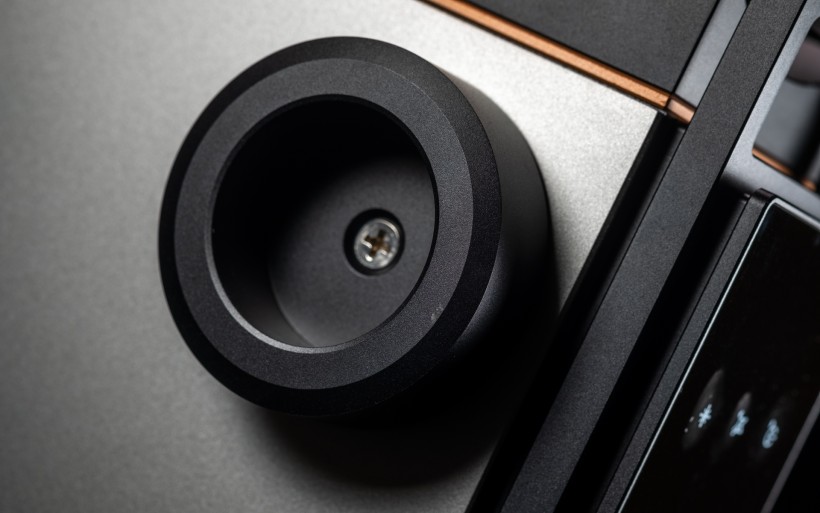 While I couldn’t compare them side by side and this is a purely academic remark, the way how the I-588 went about its business reminded me of its far dearer I-880 stablemate, which sits on the very top of my list of amps I’d like to own one day. In my room and system, the former simply proved an immensely capable platform that was equally fluent in charm, brute force and all the 50 shades of gray in between. The I-588 executed every single task to a very high standard. On each it also felt very much upscale and meticulous. I couldn’t ask for more. Ditto Boenicke speakers. I also wouldn’t expect anything less from a €30K integrated machine like this one. At this stage, the crossover network built into it had to go to work and earn its keep.
While I couldn’t compare them side by side and this is a purely academic remark, the way how the I-588 went about its business reminded me of its far dearer I-880 stablemate, which sits on the very top of my list of amps I’d like to own one day. In my room and system, the former simply proved an immensely capable platform that was equally fluent in charm, brute force and all the 50 shades of gray in between. The I-588 executed every single task to a very high standard. On each it also felt very much upscale and meticulous. I couldn’t ask for more. Ditto Boenicke speakers. I also wouldn’t expect anything less from a €30K integrated machine like this one. At this stage, the crossover network built into it had to go to work and earn its keep.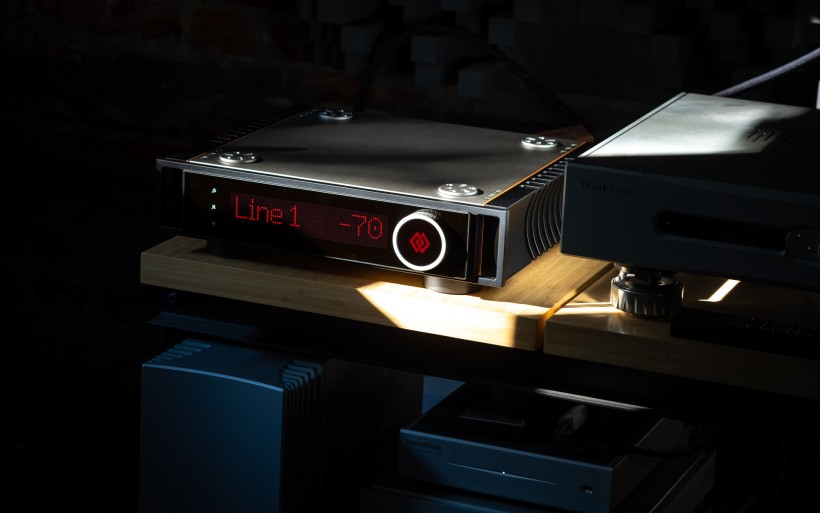 Team Aavik designed their analog crossover circuit largely with 2.1 systems in mind and rightfully so. However, upon the I-588’s arrival I didn’t have a standalone sub at my disposal. Børresen BBM is in the cards. It’s just going to take a while before it’s here. It was time to come up with a plan that’d work there and then. I had just the idea. It was quite radical and certainly not something regular shoppers interested in today’s device would ever do. For me it was firm enough to pursue it. Enter sound|kaos Vox 3afw monitors. As wickedly good as they are on imaging, articulation and all the other perks inherent to their widebander breed, monitor bass is their limiting factor. Meanwhile, Boenicke W11 SE+’s side-firing woofers can do a lot more in this department. The Aavik provided the rare opportunity not only to use both these speaker sets at the same time, but to do so accordingly to the labor division between them as outlined. That was key. To make it so, my DAC went into the I-588’s line input via RCAs just as it normally would. The latter’s low-pass out was set at 80Hz and the second RCA pair bridged it with the main input further to the right. That way Boenicke speakers connected to the Aavik essentially morphed into stereo subs crossed to not go above 80Hz. The choice of the most suitable amp for Vox monitors among those I had was painfully obvious. Enleum AMP-23R received signal from the Dane’s high-pass output set at 70Hz. And yes, that bond also wanted RCAs.
Team Aavik designed their analog crossover circuit largely with 2.1 systems in mind and rightfully so. However, upon the I-588’s arrival I didn’t have a standalone sub at my disposal. Børresen BBM is in the cards. It’s just going to take a while before it’s here. It was time to come up with a plan that’d work there and then. I had just the idea. It was quite radical and certainly not something regular shoppers interested in today’s device would ever do. For me it was firm enough to pursue it. Enter sound|kaos Vox 3afw monitors. As wickedly good as they are on imaging, articulation and all the other perks inherent to their widebander breed, monitor bass is their limiting factor. Meanwhile, Boenicke W11 SE+’s side-firing woofers can do a lot more in this department. The Aavik provided the rare opportunity not only to use both these speaker sets at the same time, but to do so accordingly to the labor division between them as outlined. That was key. To make it so, my DAC went into the I-588’s line input via RCAs just as it normally would. The latter’s low-pass out was set at 80Hz and the second RCA pair bridged it with the main input further to the right. That way Boenicke speakers connected to the Aavik essentially morphed into stereo subs crossed to not go above 80Hz. The choice of the most suitable amp for Vox monitors among those I had was painfully obvious. Enleum AMP-23R received signal from the Dane’s high-pass output set at 70Hz. And yes, that bond also wanted RCAs.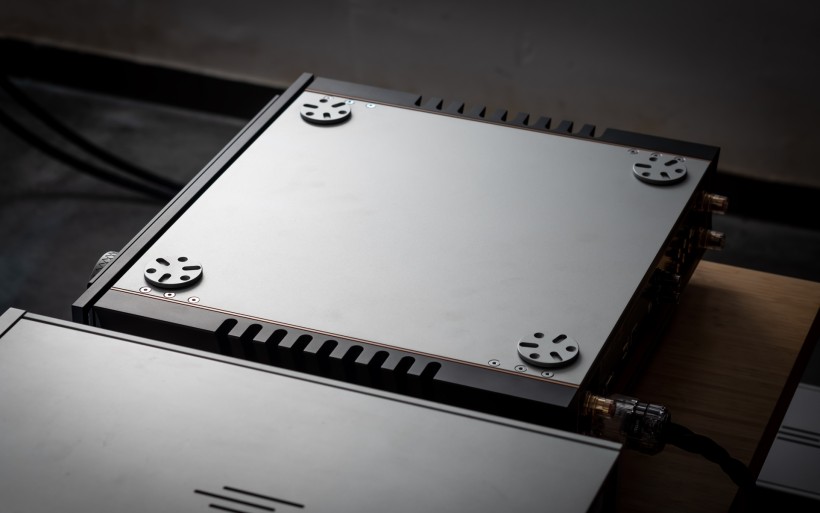 Just so we’re clear, the setup as explained doubled on speakers, amps, power cords and speaker cables. It also tripled on the necessary RCA interconnects. The view in my room was messy to say the least and too odd to show it. Not to mention that a dedicated sub would do a better job than Boenicke speakers used in that role. No matter. The purpose of this geeky experiment was neither a pretty sight nor practicality. The financial aspect didn’t matter either. It was all about the result. As it quickly turned out, it proved well worth the hassle. For years Srajan’s been vocal about intelligent analog lo-/hi-pass filtering which allows the sub and speakers to not overlap and do only what they’re really good at. The Aavik allowed me to finally grasp the gospel the man’s been preaching all this time. To say that now I’m on board with his teachings, or a neophyte, is a severe understatement. Nay, I’ve become a proper cultist. Happy days.
Just so we’re clear, the setup as explained doubled on speakers, amps, power cords and speaker cables. It also tripled on the necessary RCA interconnects. The view in my room was messy to say the least and too odd to show it. Not to mention that a dedicated sub would do a better job than Boenicke speakers used in that role. No matter. The purpose of this geeky experiment was neither a pretty sight nor practicality. The financial aspect didn’t matter either. It was all about the result. As it quickly turned out, it proved well worth the hassle. For years Srajan’s been vocal about intelligent analog lo-/hi-pass filtering which allows the sub and speakers to not overlap and do only what they’re really good at. The Aavik allowed me to finally grasp the gospel the man’s been preaching all this time. To say that now I’m on board with his teachings, or a neophyte, is a severe understatement. Nay, I’ve become a proper cultist. Happy days.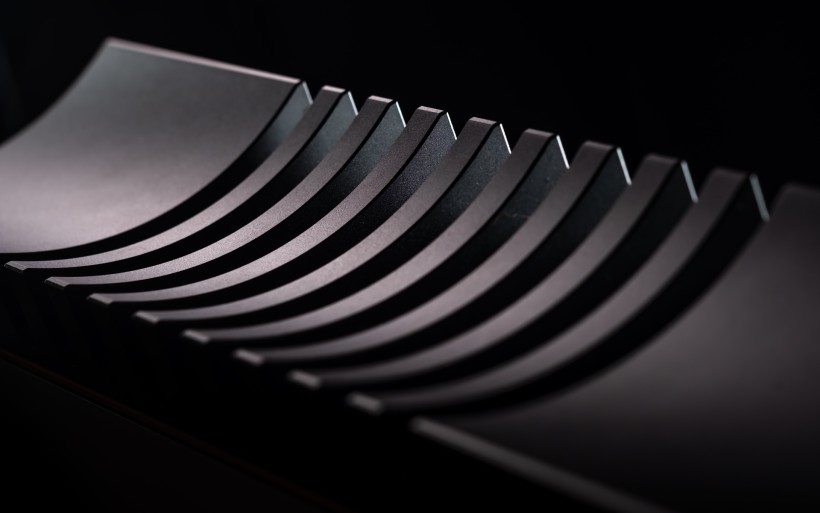 My ideal speaker type would combine full-range aesthetic from midrange upwards with RiPol bass that extends well below 25Hz. The recently reviewed Voxativ Alberich2 pulled this feat by parking one unfiltered passive widebander per channel atop its active RiPol bin. The audible outcome was glorious and the product itself unlike anything else that’s commercially available on the market right now. My award for the Alberich2 system reflected that and also clever designer choices that spawned this ambitious one-off speaker set. By now it should be clear that the Aavik allowed me to conjure up a similar rig, but comprised of my own hardware, so I could finally experience Vox with greatly evolved bottom end. That the I-588 unlocked this awesome system-building route was a massive boon on its own two legs. That its crossover circuit was agnostic on speakers and amps was yet another. Use what you have was the clear motto. On that note, Enleum AMP-23R proved very handy utility wise. While externally an integrated device, internally this is a power amp with variable gain factor. The Aavik’s massive knob regulated volume of the entire Vox/W11 SE+ combo. The Enleum amp allowed me to additionally change how loud Swiss monitors were in relation to the W11 SE+’s output, albeit without any losses due to its unusual gain manipulator. Once all levels were dialed to my liking, the game was afoot.
My ideal speaker type would combine full-range aesthetic from midrange upwards with RiPol bass that extends well below 25Hz. The recently reviewed Voxativ Alberich2 pulled this feat by parking one unfiltered passive widebander per channel atop its active RiPol bin. The audible outcome was glorious and the product itself unlike anything else that’s commercially available on the market right now. My award for the Alberich2 system reflected that and also clever designer choices that spawned this ambitious one-off speaker set. By now it should be clear that the Aavik allowed me to conjure up a similar rig, but comprised of my own hardware, so I could finally experience Vox with greatly evolved bottom end. That the I-588 unlocked this awesome system-building route was a massive boon on its own two legs. That its crossover circuit was agnostic on speakers and amps was yet another. Use what you have was the clear motto. On that note, Enleum AMP-23R proved very handy utility wise. While externally an integrated device, internally this is a power amp with variable gain factor. The Aavik’s massive knob regulated volume of the entire Vox/W11 SE+ combo. The Enleum amp allowed me to additionally change how loud Swiss monitors were in relation to the W11 SE+’s output, albeit without any losses due to its unusual gain manipulator. Once all levels were dialed to my liking, the game was afoot.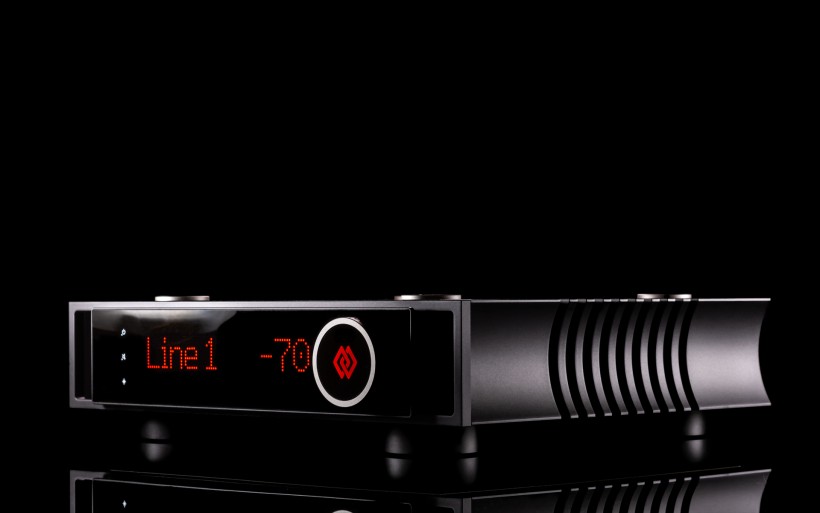 Swiss petites positioned in their usual space that secured mental imaging, clarity and associated traits, so nothing new per se. However, their full-range flavor augmented with stout W11 SE+ bass got me sound that had me floored and smiling from ear to ear. Vox monitors were significantly more alive, grand and intense than they normally are. Nothing was lost along the way, pure gains of silly-high magnitude were all that my ears detected. Granted, the demonstrable progress in terms of sheer spatial scale, dynamic span and momentum was roughly what I hoped to hear. I just had no idea that liberating Vox from bass and outsourcing it elsewhere would make such a criminally large difference. It did and I can not unhear it now. My perception of these wooden gems on their skinny legs has now changed radically. The gate to squeezing more performance out of them just opened up, courtesy of the Aavik I-588. In this instance, it achieved something no other amp before it had managed. No wonder. The remarkable I-880 aside, I simply haven’t hosted a product with the same elaborate toolkit on board. This is some seriously potent smart stuff that is also very hard to come by. I was also positively surprised how expertly the Aavik integrated both speaker sets. To my ears and taste, they acted as one enormously gifted and positively spicy speaker. There was no drag, veil or mismatch of any kind. After this adventure, the idea of using the same system with Børresen BBM instead of W11 SE+ had me all warm and fuzzy inside. Let’s wrap.
Swiss petites positioned in their usual space that secured mental imaging, clarity and associated traits, so nothing new per se. However, their full-range flavor augmented with stout W11 SE+ bass got me sound that had me floored and smiling from ear to ear. Vox monitors were significantly more alive, grand and intense than they normally are. Nothing was lost along the way, pure gains of silly-high magnitude were all that my ears detected. Granted, the demonstrable progress in terms of sheer spatial scale, dynamic span and momentum was roughly what I hoped to hear. I just had no idea that liberating Vox from bass and outsourcing it elsewhere would make such a criminally large difference. It did and I can not unhear it now. My perception of these wooden gems on their skinny legs has now changed radically. The gate to squeezing more performance out of them just opened up, courtesy of the Aavik I-588. In this instance, it achieved something no other amp before it had managed. No wonder. The remarkable I-880 aside, I simply haven’t hosted a product with the same elaborate toolkit on board. This is some seriously potent smart stuff that is also very hard to come by. I was also positively surprised how expertly the Aavik integrated both speaker sets. To my ears and taste, they acted as one enormously gifted and positively spicy speaker. There was no drag, veil or mismatch of any kind. After this adventure, the idea of using the same system with Børresen BBM instead of W11 SE+ had me all warm and fuzzy inside. Let’s wrap.
The Aavik I-588 may look like its AiO sibling, flaunting the same visually gorgeous, flawlessly executed exterior, and both machines manhandle tough speakers with staggering ease, finesse, and control. But make no mistake — this is a very different beast. Where the U-188 dazzled with convenience, today’s €30K bruiser strips away digital extras to court top-shelf DACs like mine instead and go the extra mile. Judging by how it performs where it truly counts, I’d say it more than earns that level of support.
In short, the Aavik I-588 is a muscle amp with impeccable manners — brute force in a tux, perfectly aware of its charm. What truly sets it apart, however, is its in-built analog crossover circuit: a phenomenal twist that bends the rules of its integrated class and transforms it into a genuine high-performance system-building tool. If the I-588 is raw power wrapped in elegance, then this filtering intelligence is what elevates it beyond convention, showing us where tomorrow’s high-end is most likely heading — and taking us there.
Associated Equipment:
- Amplifier: Trilogy 995R, FirstWatt F7, Enleum AMP-23R
- DAC: LampizatOr Horizon360 (Stradi 5U4G + Psvane Art TIII 4x KT88 / 2x 6SN7)
- Speakers: Boenicke Audio W11 SE+, sound|kaos Vox 3afw
- Transport: Innuos Statement, fidata HFAS1-S10U
- Preamplifier: Trilogy 915R, Thöress DFP
- Speaker cables: Boenicke Audio S3, LessLoss C-MARC
- Headphones: HifiMan Susvara
- Speaker signal conditioning: LessLoss Firewall for Loudspeakers, Boenicke ComDev
- Anti-vibration conditioning: 6x Carbide Base Diamond (under streamer), 6x Carbide Base Micro Diamond with TwinDamp inserts and spikes (under DAC and pre), Vibra 68 (under speakers), 12x LessLoss Giant Steps (under streamer, DAC and pre)
- Interconnects: LessLoss Entropic Process C-MARC, Boenicke Audio IC3 CG
- Power components: Gigawatt PC-3 SE EVO+/LC-3 EVO, LessLoss C-MARC, LessLoss Entropic C-MARC, LessLoss Stellar C-MARC, LessLoss Power Distributor into Boenicke Audio Power Gate, ISOL-8 Prometheus
- USB components: AudioPhonique Desire USB
- Rack: Franc Audio Accesories Wood Block Rack 1+3
- Network: Fidelizer EtherStream, Linksys WRT160N
- Music: NativeDSD
Retail prices of reviewed components in EU (incl. VAT):
- Aavik I-188/288/588: €20’000/25’000/30’000
Manufacturer: Aavik


